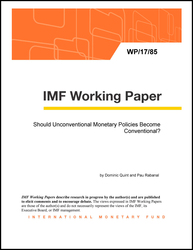
Should Unconventional Monetary Policies Become Conventional?
The large recession that followed the Global Financial Crisis of 2008-09 triggered unprecedented monetary policy easing around the world. Most central banks in advanced economies deployed new instruments to affect credit conditions and to provide liquidity at a large scale after shortterm policy rates reached their effective lower bound. In this paper, we study if this new set of tools, commonly labeled as unconventional monetary policies (UMP), should still be used when economic conditions and interest rates normalize. In particular, we study the optimality of asset purchase programs by using an estimated non-linear DSGE model with a banking sector and long-term private and public debt for the United States. We find that the benefits of using such UMP in normal times are substantial, equivalent to 1.45 percent of consumption. However, the benefits from using UMP are shock-dependent and mostly arise when the economy is hit by financial shocks. When more traditional business cycle shocks (such as supply and demand shocks) hit the economy, the benefits of using UMP are negligible or zero.
Publication date: March 2017
ISBN: 9781475591330
$18.00
Add to Cart by clicking price of the language and format you'd like to purchase
Available Languages and Formats
| English |
Prices in red indicate formats that are not yet available but are forthcoming.
Topics covered in this book
This title contains information about the following subjects.
Click on a subject if you would like to see other titles with the same subjects.
Summary
Copyright © 2010 - 2024
Powered by:
AIDC



